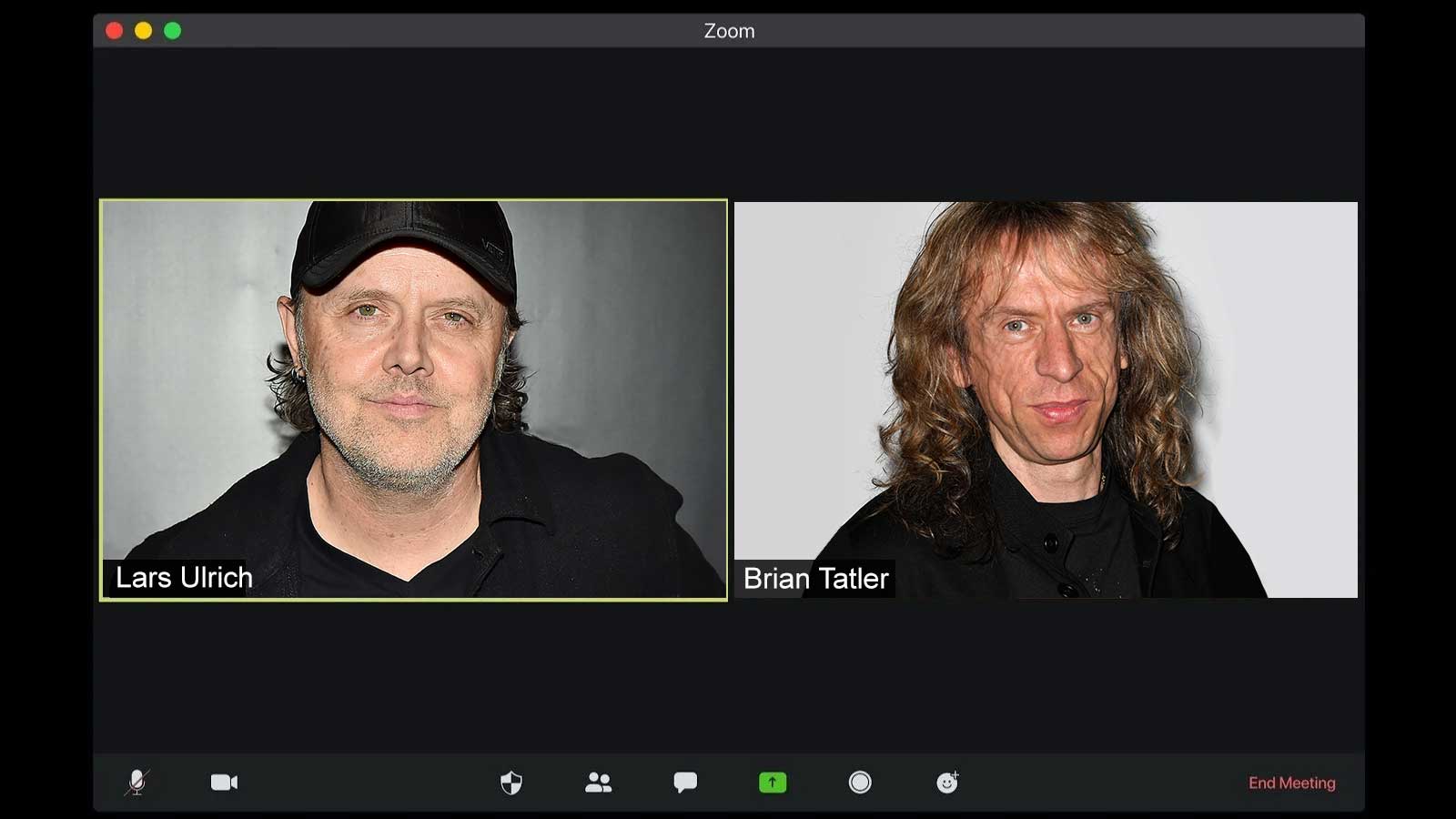It’s July 10, 1981, and Diamond Head are at the Woolwich Odeon in South London, wrapping up a 19-date UK tour promoting the previous year’s debut album Lightning To The Nations.
Like their record, the tour was self-financed by the group and their management. Lighting had received ecstatic reviews, but, tellingly, while Iron Maiden, Saxon and Def Leppard had taken vital steps forwards by securing record contracts, the Stourbridge-based four-piece wouldn’t be signed to MCA until the following year.
Among the audience in Woolwich was a Danish teenager called Lars Ulrich, who had jetted in from his Californian home for the show. The aspiring musician had written to Diamond Head’s Fan Club and received a reply from Linda Harris, mother of lead singer Sean and the band’s manager.
Prior to the show, Ulrich spent six weeks dossing down first with the Harrises and then at guitarist Brian Tatler’s place. A lifelong friendship was born. Almost four decades later, Tatler and Ulrich still talk regularly, mostly by text or email, although as Lars tells Classic Rock: “It doesn’t happen often enough.”
Both remember with fondness that fateful night in Woolwich and also the ensuing shared weeks. Diamond Head knew of Ulrich’s pilgrimage in advance, and were happy to meet a guy committed enough to fly five thousand miles to see them.
“We had thought: ‘Wow, we’ve got one fan in America, that’s a start – it can grow from there’,” Tatler recalls with typical earnestness.
When Ulrich returned to the States, things began to pick up for his own band. In a letter, Ulrich wrote: “This geezer in LA is doing a compilation album of 10 new, young LA heavy metal bands and our band are on it with a track called Hit The Lights.” The ‘geezer’ in question was Brian Slagel of Metal Blade Records. Sure enough, the track found its way on to a collection called Metal Massacre.
In the same letter, Ulrich told Tatler: “Our band is called Metallica. The lead guitarist is pretty fast. I think you’ll like him.”

Although “pretty fast” guitarist Dave Mustaine wouldn’t last long in the band, Metallica went from strength to strength. Diamond Head, conversely, were held back by amateur management, an incompatible record label, personnel instability and the type of ill fortune that made The Fast Show’s Unlucky Alf seem like a Lottery winner.
Everything imploded in 1983 when, during the pre-CD age, a manufacturing error caused all 20,000 vinyl copies of their third album, Canterbury, to skip. The following year Metallica covered Diamond Head’s Am I Evil? as a B-side, and later reworked Helpless, The Prince and It’s Electric.
This helped to fuel a three-year reunion that began in ’91, although when at the turn of the millennium Diamond Head regrouped for a third time it was without Sean Harris. The two albums the band made with brilliantly monickered singer Nick Tart helped to keep the band afloat, but all too often it appeared to be a lost cause.
They brought in London-based Danish singer Rasmus Bom Andersen two albums ago, for 2016’s Diamond Head, and it’s difficult to overstate the ripple effect caused by the London-based Dane. Diamond Head are now playing bigger gigs, receiving rave press and impacting upon a new generation of fans.
“Ras has made a great difference. Everyone seems to be more welcoming of the band with him on board,” Tatler says proudly. “We’ve become much more powerful as a live band and we’re moving in the right direction.”
“Y’see,” Ulrich says, “that’s what happens when you surround yourself with Danish people!”
Today, Diamond Head fan-boy Ulrich has a list of questions for Brian Tatler, including what happened to the album’s master multi-track tapes, and also the guy who produced it, Muff Murfin?
“I got the stereo masters thanks to you, when you rescued them from a German label,” Tatler replies. “But the original masters are still at the studio where we made the album [the Old Smithy in Worcester].”
To the second part he replies: “Muff was a singer in the 1960s. He looked a bit like Jason King (titular character in 70s TV drama Jason King, played by Peter Wyngarde).”
Ulrich also wants to know whether the debut’s first thousand copies were released in a plain white sleeve to “command a certain mystique”, or because of “limited resources”?
“More the latter,” Tatler responds, “but it definitely made it the Holy Grail for NWOBHM collectors.”
The new album’s bonus tracks see Diamond Head 2020 covering hard rock standards by Led Zeppelin (Immigrant Song), Judas Priest (Sinner) and Deep Purple (Rat Bat Blue). Most significantly they also covered Metallica’s No Remorse.
“I liked the thought of the wheel turning full circle,” Tatler says, smiling.
“Brian sent me their version [of No Remorse] a few months ago,” Ulrich adds enthusiastically, although he is yet to hear the reworked album. “I thought everything about their No Remorse was great – song, performance and sonically. It’s very cool. “Why did you pick that one, Brian?”
“I wanted to do something from the debut,” Tatler says, “and Seek And Destroy was a bit too obvious. No Remorse had a certain Diamond Head quality to it, it has our style within the writing, and in rehearsals it sounded great right away. We had to work on the others much more."
Back in 1991, with Metallica’s Black Album going stratospheric, this writer conducted a psycho analysis-themed interview with Ulrich for RAW magazine. Among the questions was: ‘You’re offered everlasting fame at the expense of a group you really admire. Do you seize the opportunity?’ Ulrich laughed, and then replied: “Didn’t we do that to Diamond Head already?”
“Hey, one thing you can never fault me for is not speaking the truth,” Ulrich says after a nervous-sounding laugh. “I cringe whenever interviewers throw me a quote from thirty years ago, because we talked such a load of shit. I had a playful relationship with the British press in those days.
"Have I said a bunch of shit along the way? Of course I have. But we [Metallica] started out as a Diamond Head cover band, and although we piggy-backed on [those roots] our own sound came out of those songs. The story [of the two bands] is one of respect, appreciation and love.”

Over the decades, both Tatler and Ulrich have been hugely significant to each other’s life. Do they sometimes wonder how things might have turned out had their worlds not collided?
“Well, the three of us would probably not be sitting here and Zooming right now,” Ulrich says, laughing. “But I don’t spend a lot of time thinking about ‘what if?’s.”
“The whole thing was beneficial for both of us,” Tatler says. “Diamond Head were an influence on Metallica, who went on to become a legendary band. Not to mention the financial implications [for us].”
Ulrich insists we should “forget about success and financial stuff”, emphasising: “Brian and I were kindred spirits. Had our stories played out differently they would still have involved music. Embracing music and making it your life was always going to be a calling for us.”
What are the chances of the two of you doing some kind of project together?
“My number hasn’t changed,” Lars says instantly. “Remember that one time at the Reading Festival when we jammed in the tuning room? And James [Hetfield] came in…”
That’s right,” Tatler says excitedly. “Shavo [Odadjian, bassist] from System Of A Down was there, and we did [Metallica’s] Battery. I didn’t know it very well butI had a go anyway.
“Our best years are still ahead of us,” says Ulrich. “Hopefully there could be something more solid in the future. Maybe we’ll write a song together or play something cool.”
Why not use lockdown to make it happen?
“That would be super-fun,” Ulrich says.
There have been rumours that Metallica will make an album during COVID downtime. What’s the progress with that, Lars?
“Glacial. These are the craziest of times and nothing is letting up. There’s a little bit of movement [in that direction], but it’s hard to do a lot when we’re not together.”
Having been born in different countries, and poles apart in terms of backgrounds (Ulrich was a rich kid whose father played tennis professionally; Tatler worked as a car mechanic after leaving school), what do the pair both have in common and how are they different?
“Lars has much more drive than me,” Tatler admits. “With someone like him in your band you’ve a far better chance. Diamond Head didn’t have that back in the day, sadly.”
Still, 39 years after they first met, and despite their very different career paths, there is one thing that continues to render the bond between Brian Tatler and Lars Ulrich unbreakable.
“Forget about Metallica and how the story played out, at heart I’m still a music fan,” Ulrich concludes. “Brian and still share that love in its purest form and it’ll never change.”
Diamond Head’s Lightning To The Nations 2020 is available now via Silver Lining Music. Metallica’s S&M2 is out now via Blackened.

